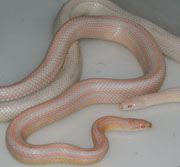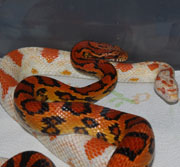Caring For Your Corn Snake

Before Brumation
Some breeders/keepers choose to brumate their corn snakes, and some don't. Although it's not necessary, there are some benefits. Brumation can help a breeder/keeper "guesstimate" when the females are ovulating. Ovulation usually happens, a couple weeks after the female's first shed. This doesn't always happen, though. Some snakes don't "go by the book."
If you choose to brumate your adult corn snakes, here are some guidelines... Stop feeding your corn snakes three weeks before the brumation period begins. During this time, keep the temperature at a normal level. This will give your snakes time to digest any food in their systems... and eliminate the waste. If snakes aren't properly "cleaned out" before brumation, it can cause major health problems. After the "clean-out" period, drop the temperature gradually until it's at the desired brumation temperature (suggested brumation temperature is 50-60 degrees F).
During and After Brumation
Monitor the brumation temperature, and make sure it stays at the proper range. Give your corn snakes fresh water during this time. It's fine to check on them and replace the water. This amount of minimal contact will not disturb them.
After the brumation period, warm your corn snakes slowly over a one to two-week period until they are kept at the normal temperature. After a week at the normal temperature, start feeding your snakes. Make sure to give them smaller than normal meals for the first couple times... and then, their systems will be adjusted to eating again.
Breeding
Place the male and female corn snakes together in a "breeding" container lined with paper towel or newspaper. The paper towel makes sure the male doesn't get any substrate caught on his hemipenis after he retracts in when the breeding is over. If you don't witness the breeding, having them on paper towels allows you to see the "evidence" as it generally leaves a yellowish spot. If desired, leave the snakes together overnight. Then, put the snakes back in their homes. Some breeders only put their snakes together for one breeding session, while others choose to pair them up 2-4 times.


